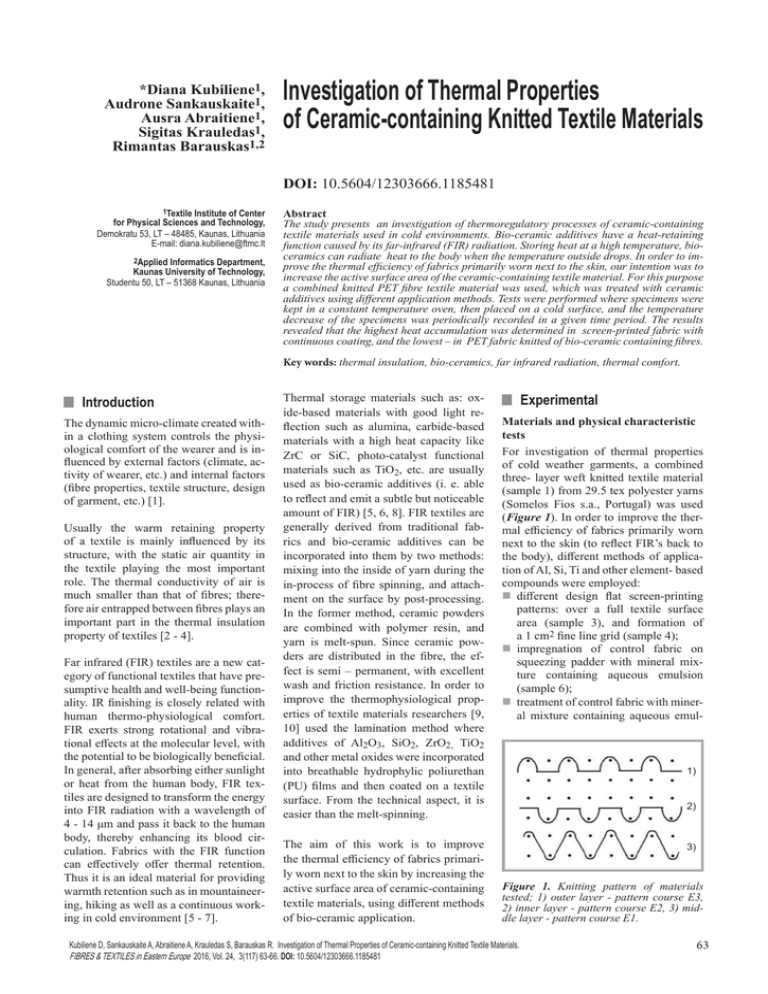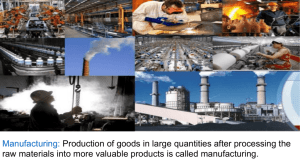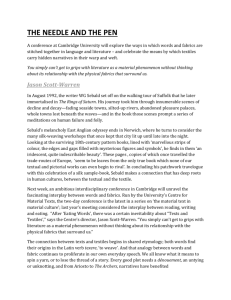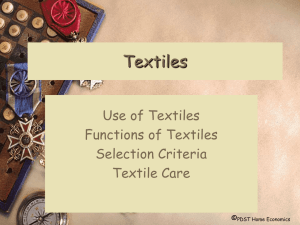Investigation of Thermal Properties of Ceramic-containing Knitted Textile Materials *Diana Kubiliene ,
advertisement

*Diana Kubiliene1, Audrone Sankauskaite1, Ausra Abraitiene1, Sigitas Krauledas1, Rimantas Barauskas1,2 Investigation of Thermal Properties of Ceramic-containing Knitted Textile Materials DOI: 10.5604/12303666.1185481 1Textile Institute of Center for Physical Sciences and Technology, Demokratu 53, LT – 48485, Kaunas, Lithuania E-mail: diana.kubiliene@ftmc.lt 2Applied Informatics Department, Kaunas University of Technology, Studentu 50, LT – 51368 Kaunas, Lithuania Abstract The study presents an investigation of thermoregulatory processes of ceramic-containing textile materials used in cold environments. Bio-ceramic additives have a heat-retaining function caused by its far-infrared (FIR) radiation. Storing heat at a high temperature, bioceramics can radiate heat to the body when the temperature outside drops. In order to improve the thermal efficiency of fabrics primarily worn next to the skin, our intention was to increase the active surface area of the ceramic-containing textile material. For this purpose a combined knitted PET fibre textile material was used, which was treated with ceramic additives using different application methods. Tests were performed where specimens were kept in a constant temperature oven, then placed on a cold surface, and the temperature decrease of the specimens was periodically recorded in a given time period. The results revealed that the highest heat accumulation was determined in screen-printed fabric with continuous coating, and the lowest – in PET fabric knitted of bio-ceramic containing fibres. Key words: thermal insulation, bio-ceramics, far infrared radiation, thermal comfort. nIntroduction The dynamic micro-climate created within a clothing system controls the physiological comfort of the wearer and is influenced by external factors (climate, activity of wearer, etc.) and internal factors (fibre properties, textile structure, design of garment, etc.) [1]. Usually the warm retaining property of a textile is mainly influenced by its structure, with the static air quantity in the textile playing the most important role. The thermal conductivity of air is much smaller than that of fibres; therefore air entrapped between fibres plays an important part in the thermal insulation property of textiles [2 - 4]. Far infrared (FIR) textiles are a new category of functional textiles that have presumptive health and well-being functionality. IR finishing is closely related with human thermo-physiological comfort. FIR exerts strong rotational and vibrational effects at the molecular level, with the potential to be biologically beneficial. In general, after absorbing either sunlight or heat from the human body, FIR textiles are designed to transform the energy into FIR radiation with a wavelength of 4 - 14 μm and pass it back to the human body, thereby enhancing its blood circulation. Fabrics with the FIR function can effectively offer thermal retention. Thus it is an ideal material for providing warmth retention such as in mountaineering, hiking as well as a continuous working in cold environment [5 - 7]. Thermal storage materials such as: oxide-based materials with good light reflection such as alumina, carbide-based materials with a high heat capacity like ZrC or SiC, photo-catalyst functional materials such as TiO2, etc. are usually used as bio-ceramic additives (i. e. able to reflect and emit a subtle but noticeable amount of FIR) [5, 6, 8]. FIR textiles are generally derived from traditional fabrics and bio-ceramic additives can be incorporated into them by two methods: mixing into the inside of yarn during the in-process of fibre spinning, and attachment on the surface by post-processing. In the former method, ceramic powders are combined with polymer resin, and yarn is melt-spun. Since ceramic powders are distributed in the fibre, the effect is semi – permanent, with excellent wash and friction resistance. In order to improve the thermophysiological properties of textile materials researchers [9, 10] used the lamination method where additives of Al2O3, SiO2, ZrO2, TiO2 and other metal oxides were incorporated into breathable hydrophylic poliurethan (PU) films and then coated on a textile surface. From the technical aspect, it is easier than the melt-spinning. The aim of this work is to improve the thermal efficiency of fabrics primarily worn next to the skin by increasing the active surface area of ceramic-containing textile materials, using different methods of bio-ceramic application. nExperimental Materials and physical characteristic tests For investigation of thermal properties of cold weather garments, a combined three- layer weft knitted textile material (sample 1) from 29.5 tex polyester yarns (Somelos Fios s.a., Portugal) was used (Figure 1). In order to improve the thermal efficiency of fabrics primarily worn next to the skin (to reflect FIR’s back to the body), different methods of application of Al, Si, Ti and other element- based compounds were employed: n different design flat screen-printing patterns: over a full textile surface area (sample 3), and formation of a 1 cm2 fine line grid (sample 4); nimpregnation of control fabric on squeezing padder with mineral mixture containing aqueous emulsion (sample 6); n treatment of control fabric with mineral mixture containing aqueous emul- 1) 2) 3) Figure 1. Knitting pattern of materials tested; 1) outer layer - pattern course E3, 2) inner layer - pattern course E2, 3) middle layer - pattern course E1. Kubiliene D, Sankauskaite A, Abraitiene A, Krauledas S, Barauskas R. Investigation of Thermal Properties of Ceramic-containing Knitted Textile Materials. FIBRES & TEXTILES in Eastern Europe 2016, Vol. 24, 3(117) 63-66. DOI: 10.5604/12303666.1185481 63 Table 1. Parameters of impregnation, exhaustion, printing and drying-curing processes. Process Auxiliaries Parameters Al-Si minerals aqueous emulsion Impregnation 40 g/l Wet pick-up 80% Nip rolls Exhaustion 10% Liquor Ratio 20 : 1 Temperature 40 ºC Time 20 min. Ti based compound paste pure paste Polyester screens mesh Printing 34 threads/cm Squeegee angle 70° Downforce Drying-curing XRF spectroscopy analysis 0.2 MPa Al-Si minerals aqueous emulsion 0.1 MPa Temperature 140 °C Time 6 min. Table 2. Characteristics of tested objects; Note: vertical density of tested fabrics PV = 7 cm-1, and horizontal density PH = 14 cm-1; thickness of the samples: 1 – 1.90 mm (as different treatment methods were applied on the basis of fabric 1, the thickness of following samples 3 - 8 remained the same), 2 – 1.75 mm. Sample code Fabric composition / treatment Mass per square Thermal meter, g/m2 resistance, m2K/W 100% PET 455 0.059 403.6 2 PET containing bio-ceramic additives 422 0.062 645.0 3 100% PET/ over full area flat screen-printing with bioceramic additives 618 0.070 116.1 4 100% PET/1 cm2 fine lines pattern flat screen-printing 567 0.061 298.0 5 100% PET fibre / N2 plasma treatment / over full area flat screen-printed paste 563 0.077 240.9 6 100% PET / impregnation 457 0.060 432.2 7 100% PET / N2 plasma treatment / impregnation 460 0.062 419.0 8 100% PET/ exhaustion 494 0.065 309.4 For obtaining better adsorption of bioceramic additives onto the surface of fabric, prior printing and impregnation by squeezing padder processes, low-pressure plasma activation was performed using an Europlasma (Belgium) machine Junior Plasma system SN 004/123C. The fabrics investigated were exposed to nitrogen (N2) gas plasma under the following conditions: system pressure 40 Pa, output power – 100 W (RF generator), and flux of gas – 10 cm3/min, time 120 s. After this treatment, the samples were placed in standard atmosphere conditions (temperature 20 ± 2 °C and relative humidity 65 ± 5%) for 24 h. The impregnation was realised using a laboratory squeezing padder EVP-350 64 Air permeability, mm/s 1 sion by the exhaustion method (sample 8); n producing a new material (Mirawave, Predilnica Litija d.o.o, Slovenia) of the same structure from PET yarns, mixed with bio-ceramic additives (29.4 tex) (sample 2). the pressure difference was 100 Pa. All tests were performed in the following climate conditions: temperature 20 ± 2 °C and relative humidity 65 ± 5%. (Roaches International Ltd, UK), printing – on a laboratory flat screen printing device (own design) and drying-curing in a laboratory oven and steamer machine - TFOS IM 350 (Roaches International, UK). The laboratory dyeing machine Ahiba Nuance ECO (Datacolor AG, Germany) was used for treatment of samples according to the exhaustion method with bio-ceramic containing auxiliaries. The parameters of the impregnation, exhaustion, printing and drying-curing processes are presented in Table 1. In this study, for thermal property investigation the physical characteristics of the fabrics measured were thermal resistance and air permeability. Thermal resistance was measured using the hot plate method according to the EN ISO 11092:2014 [11] standard, where the temperature of the hot plate was 35 °C and that in the camera - 20 °C. Air permeability was measured according to Standard EN ISO 9237:1995 [12], where The identification of the quantitative and bulk composition of different additives of infrared radiant ceramic particles containing matrices in the PET fibre, printing paste and impregnation aqueous emulsion was performed by applying X-ray fluorescence spectroscopy (XRF). Elemental analysis of pure bio-ceramic additives and knitted fabric samples before and after treatment with the auxiliaries mentioned were determined by means of a Bruker X-ray S8 Tiger WD (Bruker Corporation, Germany) spectrometer, where a Rh tube was used, anode voltage Ua under 60 kV, and current strength I - under 130 mA. The measurement was performed using He atmosphere according to the SPECTRA Plus QUANT EXPRESS method. Measurement of fabric’s heat release Tests of the fabric’s heat release were performed where specimens were kept in a constant temperature laboratory oven UFE 500 (Memmert, Germany) at 60 °C for 30 min. After this period the specimens were placed on a cold (22 ± 1 °C) flat polystyrene surface. The outer surface temperature of the specimen was periodically recorded with a thermal imaging camera – InfraCam (FLIR SYSTEMS AB, Sweden), with the following technical data: spectral range: 7.5 – 13 μm, accuracy: ±2°C or 2% of reading, and thermal sensitivity: 0.20 °C. Measurements were performed after 1 min. of specimen removal from the oven and at 1 min. time intervals till the temperature of the specimen reached the environmental temperature (22 ± 1 °C). Five specimens of the same treatment method were investigated in each test, and average temperature values were calculated when the variation coefficient did not exceed 5%. n Results and discussion Analysis of different methods of bio-ceramic application The main elements of infrared radiant ceramic additives of the samples investigated are presented in Table 3, and the influence of different methods of bioceramic application on the textiles’ heat release is given in Figures 2 and 4. FIBRES & TEXTILES in Eastern Europe 2016, Vol. 24, 3 (117) Comparing the influence of different methods of bio-ceramic application (Figure 2), the test results showed that the highest temperature accumulation was stored in the full area screen-printed sample 3 and in sample 8, which was treated by exhaustion. The average percentage of the temperature decrease rate of samples 3 and 8 were accordingly +6.3% and +5.6% higher compared to control sample 1. Analysis of samples grid screen-printed 4 and padded 6 showed very similar efficiency of method application for textile heat release, +2.3% and +1.8%, respectively, compared to sample 1. In their research Shim et al. [10] came to the conclusion that warmup suits produced by applying ceramics to hydrophilic PU films which were then incorporated into textiles, showed higher thermal insulation of textiles, although comfort properties were lower. In the research work of Bahng and Lee [8], it was stated that textile materials from ceramic-containing fibres are more resistant to washing procedures, and their hand values are superior compared to other bio-ceramic application methods. In our research it was determined that the average heat release rate of sample 2, containing bio-ceramic additives inside the fibre, was lower than results obtained by other application methods. A tenuous improvement was also determined in heat accumulation (+0.6 %) compared to control sample 1. The thermal release of the fabrics evaluated depended on the type of ceramic compound and its application method (Tables 3 and 4). XRF spectroscopy analysis (Table 4) showed that the highest bio-ceramic content was determined in flat screen-printed sample 3 (3.53%) and in sample 8 (2.51%), which was treated by exhaustion. Comparing the different bio-ceramics application methods, fine line pattern flat screen-printed sample 4 contained 1.80%, and padded sample 6 – 1.88% of mineral additives. However, sample 2, from PET fibre with polymer incorporated bio-ceramic additives, had only 1.33% of heat accumulated elements (Table 3). For deeper understanding of the ceramic additive aggregation principle for the surface structure of knitted samples, a scanning electron microscope (SEM) (Helios NanoLab 650, FEI, Netherlands) was used. The micrographs showed that the highest aggregation of ceramic additives was observed on the surface of full area printed sample 3 and on exhausted sample 8 (Figures 3.b and 3.d). FIBRES & TEXTILES in Eastern Europe 2016, Vol. 24, 3 (117) Table 3. XRF element analysis of main bio-ceramic additives. Quantity of main elements, wt. % Bioceramic PET fiber Mineral mixture aqueous emulsion Printing paste Si 0.55 Ti 2.90 Si 2.81 Fe 0.16 Mn 1.38 Cl 0.88 Zn 0.12 Fe 1.07 Al 0.43 Sb 0.11 Si 0.51 S 0.29 Cu 0.07 S 0.30 Na 0.15 Other 0.32 Other 1.19 Other 0.38 Table 4. XRF analysis results of PET knitted fabrics with main bio-ceramic additives. Sample Element, wt. % Al Si S Cl K Ca Ti Other 3 - 0.14 0.22 0.12 0.12 0.15 1.60 1.18 4 - 0.43 0.22 0.04 0.04 0.11 0.71 0.25 5 - 0.17 0.48 0.07 0.07 0.09 4.15 4.67 6 0.12 0.36 0.48 0.07 0.04 0.04 - 0.77 7 0.13 0.37 0.49 0.06 0.03 0.04 - 0.78 8 0.23 0.69 0.49 0.16 0.03 0.13 - 0.78 The same tendency was obtained from fabric thermal resistance tests (Table 2): it’s obvious that higher heat accumulation was determined in fabrics with a higher bio-ceramic content. Air permeability test results highlighted the difference between bio-ceramic application methods: flat screen-printed fabrics contained ceramic additives only on their surface, forming a continuous coating, and thereby decreasing the air permeability value. By applying impregnation treatment, the air permeability of the fabrics evaluated even increased compared to the control one, which could be explained by fibre-ceramic molecular interconnections (bonds) during the impregnation process. Alhough control sample 1 and sample 2 (PET containing bio-ceramic additives) were manufactured with the same knitted structure, both fibres’ linear density was almost the same ( 29.5 tex and 29.4 tex, respectively), with the fibre structure and composition having a critical influence on the fabrics’ physical properties. A significant difference was obtained in air permeability values, and the thermal efficiency of ceramic-containing fibre showed no significant improvement. Analysis of plasma-treatment influence To improve the adsorption of bio-ceramic additives onto the surface of fabric, prior printing and impregnation procedures as well as the low-pressure nitrogen plasma activation procedure were performed. Figure 2. Influence of different methods of bio-ceramic application on textiles’ heat release. 65 a) b) c) d) a) T, °C T, °C Figure 3. SEM micrographs (original magnification: 1000×) of knitted fabric samples: 1 (a), 3 (b), 6 (c) and 8 (d). b) t, min t, min Figure 4. Plasma-treatment influence on textiles’ heat release after applying the bio-ceramicscreen-printing (a) and impregnation (b) methods. Analysing test results of the textiles’ heat release after application of bioceramics by the screen-printing method, it was determined that nitrogen plasma treatment slightly improved the thermal storage capacity of the textile structure. XRF data in Table 4 show how activation of the fabric surface by plasma gas influenced adsorption of bio-ceramic additives: i.e., nitrogen plasma application, increased the quantity of the mineral mixture in sample 5 by 2,5 times compared to coated sample 3. Analysis of the textiles’ heat release properties showed that the results obtained were relevant to the bio-ceramic composition in separate samples (Figure 4.a). As sample 5 contained the maximal mineral quantity, its thermal accumulation was higher compared to sample 3. Nitrogen plasma treatment for better adsorption of bio-ceramic additives in screen-printing method application showed some improvement in the textiles’ heat release properties. The same investigation was performed analysing the plasma influence on impregnation method efficiency (Table 4 and Figure 4.b). Nevertheless, after plasma treatment no significant difference was obtained in the textiles’ heat release properties. As XRF analysis showed, N2 plasma increased the quantity of bio-ceramic elements applied on sample 7 only 66 by 0.02 - 0.03% compared to untreated sample 6, which led only to a tenuous increase in the textile’s temperature at the very beginning of the test, but no continuous improvement. nConclusions 1. The highest dynamic heat accumulation is directly related to the quantitative composition of bio-ceramic additives in different matrices. 2. Comparing the efficiency of different methods of bio-ceramic additive application, it was determined that the most significant thermal resistance improvement was made using the full area flat screen-printing method, although the air permeability properties of these samples became worse. 3. Promising results were received investigating the exhaust method: heat accumulation data of the fabrics could be compared to those for full area screen-printed; however, the hand properties of exhausted fabrics were far better. 4. Nitrogen plasma treatment slightly improved the adsorption of bio-ceramic additives through screen-printing and impregnation method application. Acknowledgement: This research was funded by a grant (No. MIP-044/2014) from the Research Council of Lithuania. References 1. Scott RA. Textiles for Protection, Cambridge: Woodhead Publishing Limited, 2005, 31-88. 2. Xu W, Shyr T, & Yao M. Textile Research Journal, 2007; 77, 7: 513–519. 3. Ziaei M, & Ghane M. Journal of Industrial Textiles, 2012; 43, 1: 20-33. 4. Matusiak M, Sikorski K. Fibres & Textiles in Eastern Europe, 2011, 19, 6 (89): 94100. 5. Pan N, Sun G. Functional Textiles for Improved Performance, Protection and Health, Cambridge: Woodhead Publishing Limited, 2011, 184–197. 6. Furuta T, Shimizu Y, Kondo Y. Textile Research Journal, 1996; 66, 3: 123-130. 7. Leung TK, Lin JM, Chien HS, Day TC. Textile Research Journal, 2012; 82, 11: 1121-1130. 8. Bahng GW, Lee JD. Textile Research Journal, 2014; 84, 11: 1220-1230. 9. Park CH, Shim MH, Shim HS. Key Engineering Materials, 2006; 321-323: 849852. 10. Shim MH, Park CH, Shim HS. Textile Research Journal, 2009; 79, 17: 15571564. 11. ISO 11092:2014. Textiles – Physiological effects – Measurement of thermal and water-vapour resistance under steady-state conditions (sweating guarded-hotplate test). 12. ISO 9237:1995. Textiles – Determination of permeability of fabrics to air. Received 09.07.2015 Reviewed 23.10.2015 FIBRES & TEXTILES in Eastern Europe 2016, Vol. 24, 3 (117)







